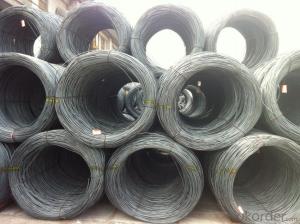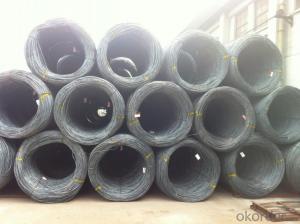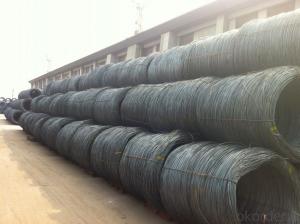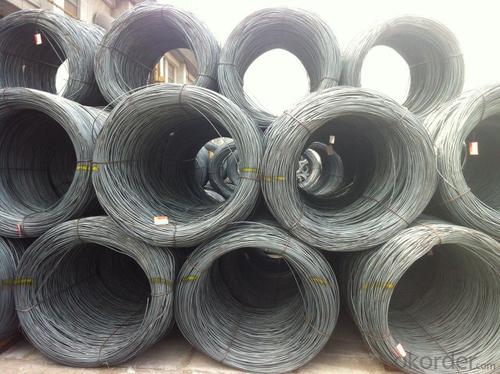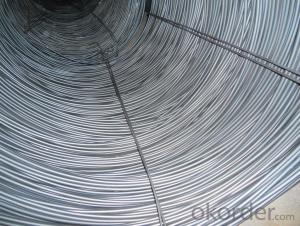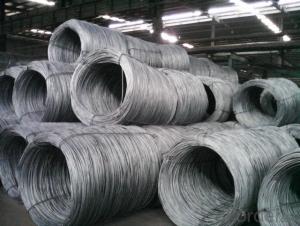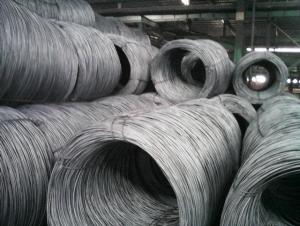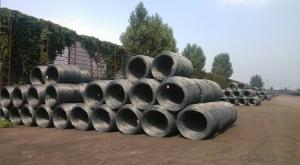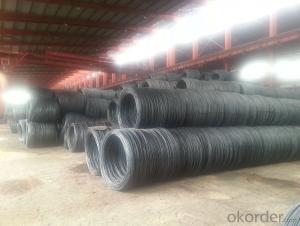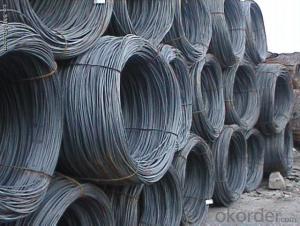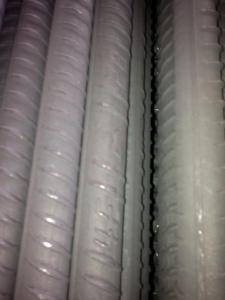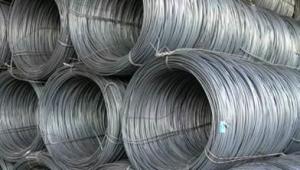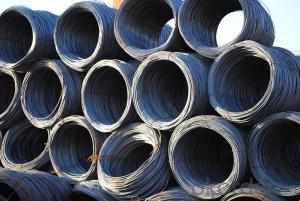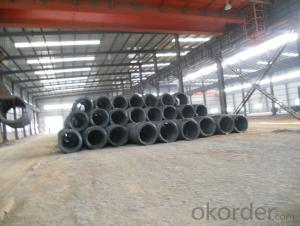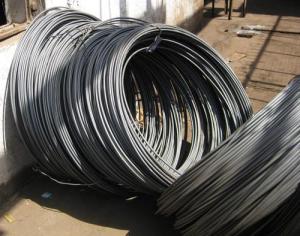High Quality Hot Rolled Wire Rod Carbon Steel
- Loading Port:
- Tianjin
- Payment Terms:
- TT OR LC
- Min Order Qty:
- 20 m.t.
- Supply Capability:
- 2000 m.t./month
OKorder Service Pledge
OKorder Financial Service
You Might Also Like
Product Description:
OKorder is offering Carbon Steel Wire Rod at great prices with worldwide shipping. Our supplier is a world-class manufacturer of steel, with our products utilized the world over. OKorder annually supplies products to European, North American and Asian markets. We provide quotations within 24 hours of receiving an inquiry and guarantee competitive prices.
Product Applications:
Carbon Steel Wire Rod are ideal for structural applications and are widely used in the construction of buildings and bridges, and the manufacturing, petrochemical, and transportation industries.After hot-rolled the products shaped into coil and delivery as finished product, including round, square, rectangular, hexagonal and so on. Since most of the products are round, it is generally called wire rod. Carbon steel wire rod is widely used in construction and manufacturing. Carbon steel wire rod is mainly used for reinforcement of reinforced concrete and welded structure or reprocessed (roberts , nail, etc.) materials, especially used to produce wire drawing, welding electrode, nails, spring, electronic, precise machinery parts and so on.
Product Advantages:
OKorder's Carbon Steel Wire Rod are durable, strong, and resist corrosion.
Main Product Features:
· Premium quality
· Prompt delivery & seaworthy packing (30 days after receiving deposit)
· Corrosion resistance
· Can be recycled and reused
· Mill test certification
· Professional Service
· Competitive pricing
Product Specifications:
Chemical Composition:
Please kindly find our chemistry of our material based on SAE1008B as below for your information
| Trademark | Rank | Chemical composition (quality score) % | ||||
| C | Si | Mn | S | P | ||
| ≤ | ≤ | ≤ | ||||
| Q195 | 0.06-0.12 | 0.30 | 0.25 | 0.050 | 0.045 | |
| Q235 | A | 0.14-0.22 | 0.30 | 0.30-0.65 | 0.050 | 0.045 |
| Q235 | B | 0.12-0.20 | 0.30 | 0.30-0.70 | 0.045 | 0.045 |
Packaging & Delivery of Wire Rod
Packaging Detail: products are packed in coil and then shipped by container or bulk vessel
Each coil weight: 2-3MT
Delivery Detail: within 45 days after received deposit or LC.
Label: to be specified by customer, generally, each bundle has 1-2 labels
Trade terms: CFR, CIF
Note:
1. Our products are produced according to national standard (GB), if not, supply according to national standards (GB) or agreement as customer required.
2. Other Grade and Standard carbon steel wire rod we can supply:
Grade: H08A, 30MnSi, 62B-82B
Standard: AISI, BS, JIS, DIN
The Minimum Order Quantity of these products is high, and need to be confirmed.
3. We can not only supply carbon steel wire rod; if you need anything about building materials, please contact us.
4. Please send us your detail specifications when inquire. We will reply to you as soon as possible. We sincerely hope we can establish a long stable business relationship.
FAQ:
Q1: Why buy Materials & Equipment from OKorder.com?
A1: All products offered byOKorder.com are carefully selected from China's most reliable manufacturing enterprises. Through its ISO certifications, OKorder.com adheres to the highest standards and a commitment to supply chain safety and customer satisfaction.
Q2: How do we guarantee the quality of our products?
A2: We have established an advanced quality management system which conducts strict quality tests at every step, from raw materials to the final product. At the same time, we provide extensive follow-up service assurances as required.
Q3: How soon can we receive the product after purchase?
A3: Within three days of placing an order, we will begin production. The specific shipping date is dependent upon international and government factors, but is typically 7 to 10 workdays.
Image
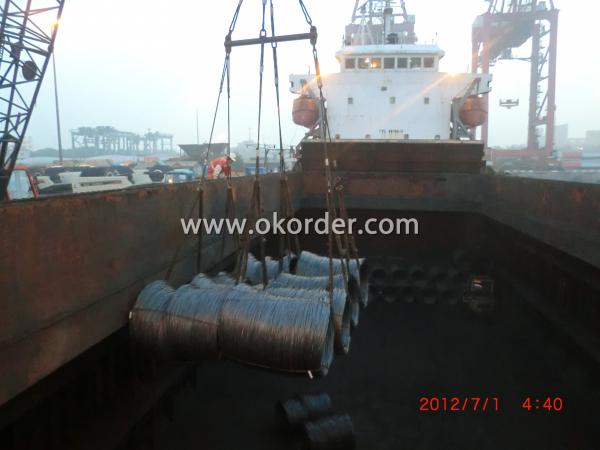
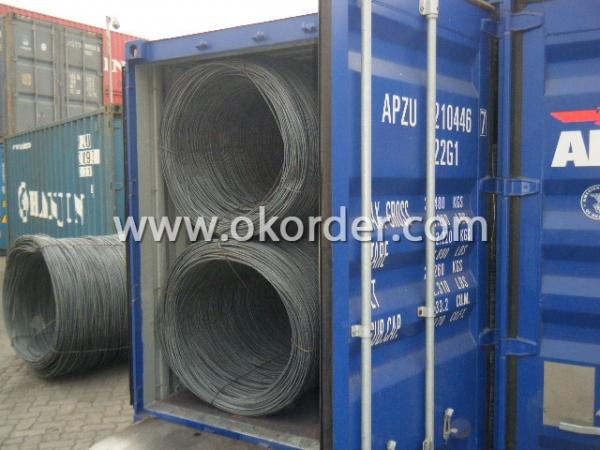
- Q: How is steel wire rod used in the manufacturing of suspension cables for bridges?
- Steel wire rod is an essential component in the manufacturing of suspension cables for bridges. It is used as the primary material for constructing the main cables that support the weight of the bridge deck. The steel wire rod is highly durable and possesses excellent tensile strength, allowing it to bear the immense load and provide stability to the bridge structure. By weaving multiple strands of steel wire rod together, suspension cables are formed, which are then anchored at each end of the bridge. These cables distribute the weight of the bridge evenly, ensuring its structural integrity and enabling the safe passage of vehicles and pedestrians.
- Q: Can steel wire rod be used for welding applications?
- Yes, steel wire rod can be used for welding applications. Steel wire rods are commonly used as a filler material in welding processes. They are typically made from low carbon steel and are available in various sizes and grades to meet specific welding requirements. Steel wire rods can be used for welding applications such as arc welding, MIG welding, TIG welding, and spot welding. They provide a strong and reliable weld when used correctly. However, it is important to select the appropriate wire rod based on the type of metal being welded and the specific welding process being used.
- Q: What are the different types of defects that can occur in steel wire rod?
- There are several different types of defects that can occur in steel wire rods. These defects can arise during the manufacturing process or as a result of various external factors. Some common types of defects include surface defects, internal defects, and dimensional defects. Surface defects are often the most visible and can include scratches, pits, cracks, and scale. These defects can occur due to improper handling or storage of the wire rod, as well as issues during the rolling or finishing processes. Surface defects can affect the appearance and functionality of the wire rod and may require further processing or treatment to rectify. Internal defects are defects that occur within the structure of the wire rod and are not visible from the surface. These defects can include inclusions, voids, and segregations. Inclusions are foreign particles that have become trapped within the steel matrix during the manufacturing process. Voids are areas of missing material, while segregations refer to variations in the composition or structure of the steel. Internal defects can weaken the wire rod and reduce its mechanical properties, making it more prone to failure under stress or load. Dimensional defects refer to variations or deviations from the specified dimensions or tolerances of the wire rod. These defects can include variations in diameter, out-of-roundness, straightness, or surface finish. Dimensional defects can occur due to issues with the rolling process, improper cooling or heat treatment, or variations in the raw material used. These defects can affect the suitability and performance of the wire rod for its intended application. It is important to note that the occurrence of defects can be minimized through proper manufacturing practices, quality control measures, and adherence to industry standards and specifications. Regular inspection and testing of wire rods can help detect and address any defects, ensuring the production of high-quality and reliable steel wire rods.
- Q: What are the common production processes for low carbon steel wire rod?
- The common production processes for low carbon steel wire rod include heating and melting the steel, casting it into billets, hot rolling the billets into wire rod, cooling and coiling the wire rod, and finally, inspection and packing.
- Q: How are steel wire rods used in the production of wire hangers for hanging clothes?
- Steel wire rods are an essential component in the production of wire hangers for hanging clothes. These rods are typically made from high-quality, durable steel, which provides the necessary strength and rigidity to support the weight of garments. The first step in the production process involves cutting the steel wire rods into the desired length for the hangers. This can be done using specialized machinery or through manual cutting methods. Once the rods are cut, they are then bent into the familiar hanger shape, typically using a combination of automated bending machines and skilled workers. The steel wire rods are manipulated and shaped to form the top hook of the hanger, which allows it to be hung on a closet rod or other hanging mechanisms. Additionally, the rods are bent to form the curved body of the hanger, which provides a secure and stable structure for hanging clothes. After the basic shape of the hanger is formed, the steel wire rods may undergo additional processes to improve their functionality and aesthetics. This may include coating the rods with a layer of protective material, such as plastic or vinyl, to prevent rusting and provide a smooth surface for hanging delicate fabrics. The hangers can also be painted or coated with a variety of colors or finishes to match different branding or aesthetic preferences. Overall, steel wire rods play a crucial role in the production of wire hangers for hanging clothes. Their strength, durability, and versatility make them an ideal material for creating hangers that can support a wide range of garments. Whether it's in homes, retail stores, or laundry facilities, wire hangers made from steel wire rods are a staple tool for organizing and displaying clothes.
- Q: What are the main factors affecting the market innovation of steel wire rod?
- The main factors affecting the market innovation of steel wire rod include technological advancements, changes in consumer demand, competition within the industry, government regulations and policies, and the availability and cost of raw materials.
- Q: What are the main factors affecting the market certifications of steel wire rod?
- The main factors affecting the market certifications of steel wire rod include the quality of the raw materials used in its production, adherence to manufacturing standards and processes, compliance with environmental and safety regulations, product testing and inspection, and meeting customer requirements and specifications. Additionally, factors such as reputation and trustworthiness of the manufacturer, market demand, and competitive pricing also play a role in obtaining market certifications for steel wire rod.
- Q: What are the common applications of galvanized steel wire rod?
- Due to its unique properties and benefits, galvanized steel wire rod finds wide-ranging applications in various industries. Below are some examples of how it is commonly used: 1. In the construction industry, galvanized steel wire rods are extensively employed to reinforce concrete structures such as beams, columns, and foundations. The galvanized coating provides resistance to corrosion, making it suitable for outdoor applications where exposure to moisture and harsh weather conditions is common. 2. For manufacturing fences, wire mesh, and barriers, galvanized steel wire rod is commonly used. The galvanized coating enhances the wire's durability and makes it rust-resistant, ensuring a longer lifespan even in outdoor environments. 3. The automotive industry also utilizes galvanized steel wire rods for various applications. These rods are used in the manufacturing of automotive parts like springs, suspension systems, and brake cables. The galvanized coating provides protection against corrosion, ensuring the longevity and reliability of these components. 4. In the agricultural sector, galvanized steel wire rods are extensively used for making wire fences, trellises, and supports for plants and crops. The galvanized coating protects the wire from rusting, ensuring its durability in agricultural environments that are often exposed to moisture and chemicals. 5. Galvanized steel wire rods are also employed in electrical applications, such as the manufacturing of electrical wires, cables, and conductors. The galvanized coating provides an additional layer of protection against corrosion, ensuring the safety and longevity of electrical installations. 6. The packaging and binding industry also benefits from the use of galvanized steel wire rods. These rods are utilized for making wire ties, baling wire, and various packaging materials. The galvanized coating provides strength and durability, making it ideal for securing and bundling different materials. These examples demonstrate just a few of the common applications of galvanized steel wire rod. Its versatility, strength, and corrosion resistance make it a valuable material in numerous industries and sectors.
- Q: How does the tensile strength of steel wire rod vary with different wire drawing processes?
- The tensile strength of steel wire rod can differ greatly depending on the specific wire drawing method employed. Wire drawing, a metalworking process that involves reducing the wire's diameter by pulling it through a series of dies, can yield varying results on the tensile strength of the steel wire rod based on the chosen technique, such as cold drawing, hot drawing, or intermediate drawing. In cold drawing, the steel wire rod is pulled through a die at room temperature. This procedure can significantly enhance the wire rod's tensile strength. Cold drawing aligns the crystalline structure of the metal, leading to increased strength and hardness of the wire. Moreover, the cold drawing process tends to yield a smooth and uniform surface finish for the wire. Conversely, hot drawing involves pulling the steel wire rod through a die at high temperatures. Although this process can also augment the wire rod's tensile strength, the effect is not as pronounced as in cold drawing. Hot drawing enables greater plastic deformation of the steel, enhancing ductility and reducing brittleness. However, due to the elevated temperatures involved, the wire produced through hot drawing may have a rougher surface finish. Intermediate drawing, which combines both cold and hot drawing processes, provides further control over the mechanical properties of the wire, including tensile strength. In this method, the steel wire rod undergoes hot drawing initially, followed by cold drawing. This combination allows for improved strength and ductility, as the hot drawing process enhances plastic deformation, while the subsequent cold drawing aligns the crystalline structure. To summarize, the tensile strength of steel wire rod can vary depending on the wire drawing process employed. Cold drawing generally results in the most substantial increase in tensile strength due to the alignment of the crystalline structure. Hot drawing and intermediate drawing processes also enhance strength but to a lesser extent, while offering additional benefits such as improved ductility and reduced brittleness. The choice of the specific wire drawing process depends on the desired mechanical properties and surface finish of the wire.
- Q: What is the weight of a standard steel wire rod coil?
- The weight of a standard steel wire rod coil can vary depending on its size and specifications. However, a typical weight range for a standard steel wire rod coil is around 2,000 to 5,000 pounds (907 to 2,268 kilograms). It is important to note that the weight can also be influenced by the diameter and length of the wire rod coil, as well as the specific type of steel used.
Send your message to us
High Quality Hot Rolled Wire Rod Carbon Steel
- Loading Port:
- Tianjin
- Payment Terms:
- TT OR LC
- Min Order Qty:
- 20 m.t.
- Supply Capability:
- 2000 m.t./month
OKorder Service Pledge
OKorder Financial Service
Similar products
Hot products
Hot Searches
Related keywords
